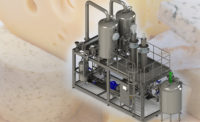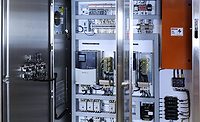Engineering R&D
Heat exchangers get better with age

Arnold Kleijn, product development director at HRS Heat Exchangers.
Photo courtesy of HRS Heat Exchangers

The R Series scraped surface heat exchanger uses a reversible helical screw to recover product without damaging the goods.
Photo courtesy of HRS Heat Exchangers


Unlike an infinitely popular PC operating system that gets more complex as it ages—with layers upon layers of spaghetti code requiring ever increasing processing power to keep up—some things actually get better with age as creative engineering improves performance, decreases energy usage and makes a device more efficient and better able to handle a new range of food or beverage products. I’m thinking heat exchangers—not software!
With a slew of patents to its name, HRS Heat Exchangers has been around since 1981 and has been making thermal products for a number of industries, including food, pharma, chemicals, water and waste-to-energy, etc. The manufacturer makes several types of heat exchangers, such as shell and tube, brazed plate, corrugated tube, scraped surface and more. In fact, the R Series has been covered in FE going back to 2014.
The R Series is a helical, scraped-surface heat exchanger, which has seen a number of food and beverage applications over the years and has evolved through engineering improvements in single-, three- and six-tube versions. There also is a heavy duty model (RHD Series), recently developed to handle viscous applications, such as chocolate-based dressings, ketchup, cheese sauces, dairy and vegetable concentrates—for example, condensed milk, tomato paste, nut butters or honey.
What’s novel about adapting the heat exchanger to new applications? Here are a couple of examples.
The R Series can be run in reverse to improve product recovery, which has proved a success with high-cost products. The company has successful applications with chocolate tempering, and the R Series has been installed as crystallizers in an environmental ZLD (zero liquid discharge) application.
I spoke with Arnold Kleijn, product development director at HRS Heat Exchangers, to get a few more details on what’s in the works.
FE: When HRS got started nearly 40 years ago, what were the first types of heat exchangers you made?
Arnold Kleijn: We started the business in the HVAC Industry using PHE’s (plate heat exchangers).
FE: You obviously saw a great need for special types of heat exchangers in food and beverage applications? What were your first solutions?
Kleijn: When we acquired a business in Spain we started out with our corrugated shell-and-tube type heat exchangers with three main types: double-tube, triple-tube and multi-tube.
FE: The R Series is a scraped surface, helical rotating device. How is this different from a helical coil heat exchanger?
Kleijn: It bears no resemblance to a helical coil heat exchanger; they are normally double-tube or tube-in-tube type and are not scraped surface. The helix is a screw conveyor welded to the scraper bar to reduce pressure drop and assist with mixing of the product for better heat transfer. It can reach velocities of up to 300 rpm, resulting in very high levels of shear and increasing the heat transfer rate.
FE: How is the R Series different from other rotating heat exchangers?
Kleijn: There are various reasons; here is a quick list:
- Multi-tube option (up to six tubes in a single heat exchanger)
- Multi-pass option
- The helical screw
- Longitudinal baffles (improves heat transfer)
- Removable tubes
- Heavy-duty version
FE: You mentioned the R Series can be run in reverse for cleanouts. Why do this? Is HRS the only one to do this?
Kleijn: To enhance product recovery and minimize waste and save costs, as far as we know we are the only company to offer this.
FE: What were the design considerations for the heavy-duty RHD Series?
Kleijn: We did a trial on nut butter with the standard R Series, and the unit wasn’t strong enough, so we redesigned the unit to cope with the arduous duty, which resulted in making the following design changes:
- Stronger gearbox (metal parts not plastic)
- Larger diameter scraper bar
- Extra scraper supports
- Extra motor support
FE: Could you tell us about the new developments to the R and RHD Series since 2018?
Kleijn: The multi-pass option for the R3; the RMP multi-pass arrangement links each of the three tubes in series: product enters through one tube, passes down the next and then moves back up the third. The use of longitudinal baffles in the outer shell achieves a true counter-current flow to improve heat exchange efficiency.
FE: What are some applications for the R and RHD Series?
Kleijn: We wanted to handle some tough applications that always presented flow problems, for example, heating and cooling viscous and fouling foods, such as nut butters, honey, meat pastes, jams and diced fruits. In addition, these heat exchangers work in chocolate tempering and pet food applications.
FE: You also have a patented reciprocating model called Unicus. Describe its operation and intended applications.
Kleijn: The Unicus design is based on a traditional shell-and-tube heat exchanger with scraping elements inside each tube. The reciprocating movement of the scrapers mixes the fluid while cleaning the heat exchange surface. This keeps heat transfer high and reduces downtime. In addition, the scraping movements introduce turbulence in the fluid increasing levels of heat transfer.
This design makes the Unicus Series the ideal heat exchanger for applications where fouling or low heat transfer is a limiting factor. The Unicus Series can be applied in industrial and hygienic applications.
The gentle movement of the scrapers allows the system to be used with delicate products, such as whole fruit or vegetable pieces, without destroying the product integrity.
FE: Which came first: R Series or Unicus?
Kleijn: The Unicus.
For more information, visit www.hrs-heatexchangers.com/us
Looking for a reprint of this article?
From high-res PDFs to custom plaques, order your copy today!









